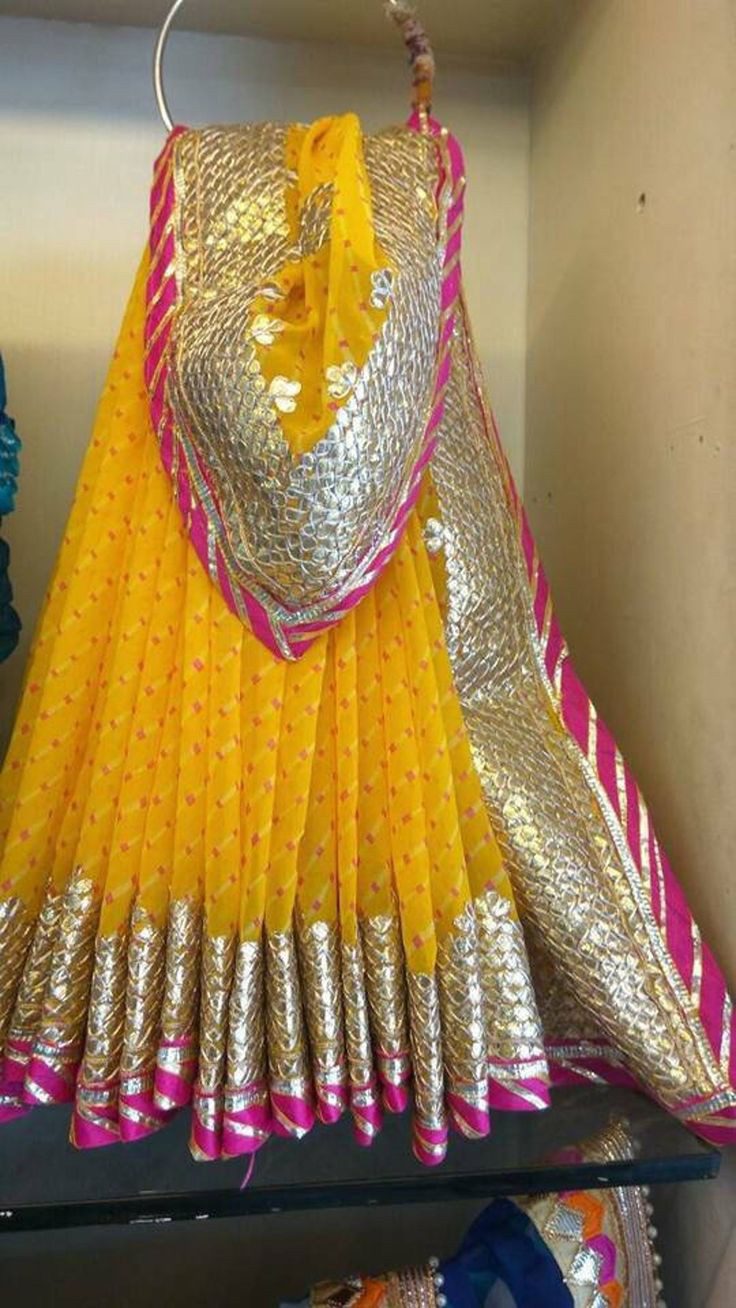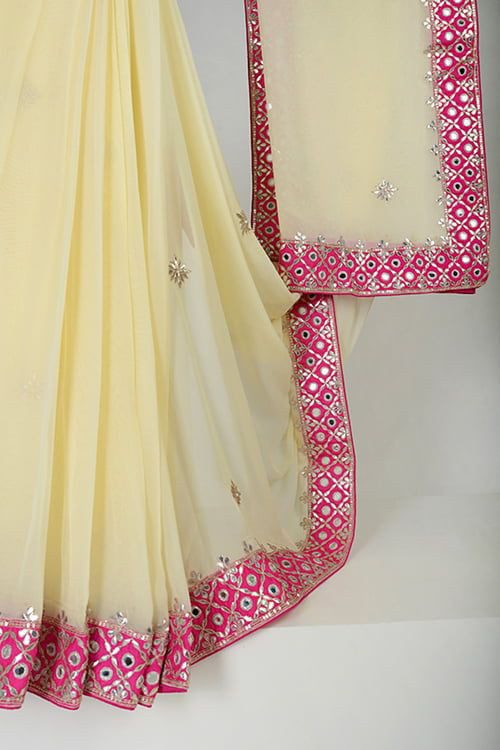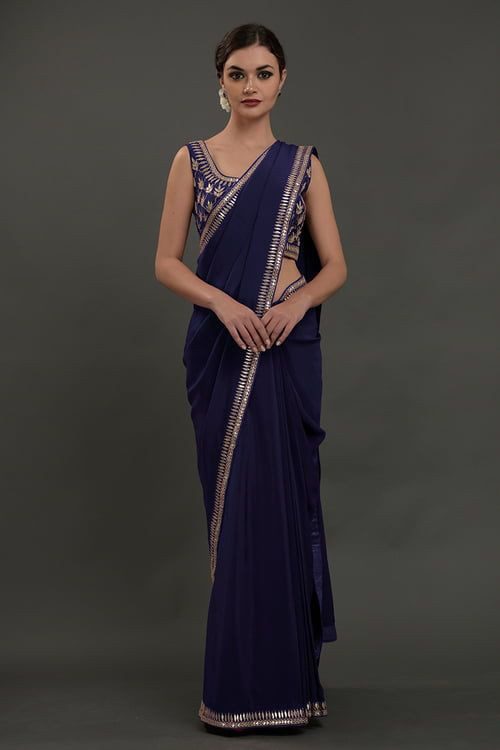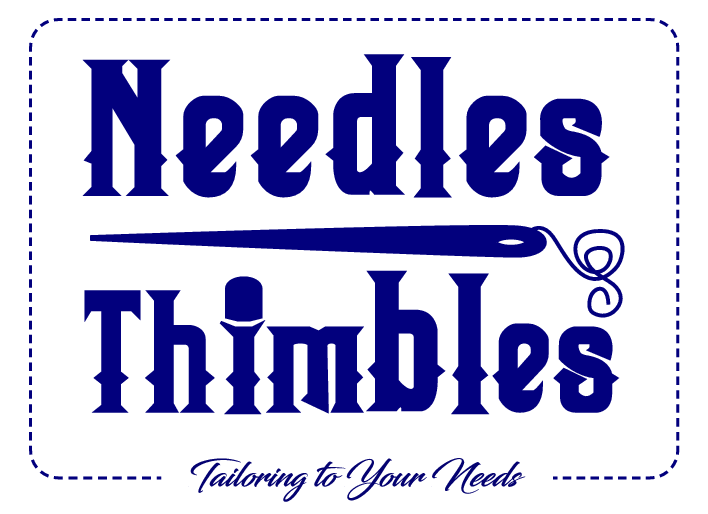India’s Rajasthan is the birthplace of Gota Embroidery stitching / Patti Work (also known as Gota-Kinari Work or Lappe ka Kaam), which is a type of metal embroidery. In Jaipur, Bikaner, Ajmer, Udaipur, and Kota, Gota work is renowned for its unique aesthetic and design. Gold, silver, copper, and other metals are appliquéd to create intricate patterns. Applications include embellishing bridal Sarees and Lehengas with this technique. In Rajasthan, dupattas and ghagras are frequently embellished with gota embroidery on auspicious occasions.
What Is Gota Embroidery
India is known for its diverse traditions and cultures and especially for its unique art and craft styles. Indian handlooms come in a wide variety of styles and embroidery patterns that are worn by everyone. Gotta Patti is also one of them. It is a type of embroidery that originated in Rajasthan and is one of many types of embroidery that originated in India. Gotta Patti became popular among the Rajasthani royals as a way to decorate their clothing. A zari-ribbon applique technique is used to apply zari ribbons to the fabric. Intricate and elegant patterns are created by sewing zari along the edges of the garments.
A gold or silver ribbon or thread from Lucknow is known as gotta. However, today’s colored ribbons woven in satin or twill are also known by the same name as well. All of these ribbons are different in terms of size and thickness. They are also used in kinari work, which adds a special touch to the garment. Fabrics such as georgette or bandhani were often embroidered with Gotta embroidery to create unique patterns and surface textures. Gold and silver threads were popular among the elites in the past.
History and Origin
In Rajasthan, gota embroidery has been used for thousands of years to embellish lehenga cholis, kurtas, aprons, and dupattas with its dazzling and surreal designs. In the Mughal period, almost everything was decorated with gota work. Gota work was used as a common form of embellishment on everything from clothing to bedspreads to bags to furniture. Bikaner, Ajmer, Jaipur, and Udaipur craftsmen are known for their dextrous gota embroidery skills.
The Making Of Gota Embroidery
Gota’s production is a lengthy and time-consuming task. Khaat, or the four thick cords of the wooden frame, are tied to the base fabric. To begin, a craftsman uses tracing paper and chalk powder paste to trace the design onto fabric. The Gota fabric is cut and folded into various shapes based on the design requirements. The fabric is then backstitched and hemmed. Gota’s motifs are drawn from the natural world. The popular Gota motifs include flowers, leaves, birds, and animals.
Innovations Using Gota Embroidery Stitching
Cushion covers, bedsheets, Jhola bags (ethnic purses), shoes, household accessories, and rugs are all common places to find gota work. Over the last few years, such pieces of handiwork have become increasingly popular, and they continue to dominate Indian fashion. Silver and gold gota borders adorn the rich shades of dark green, black, red, magenta, brown, and yellow fabrics in traditional and beautiful Anarkali suits.

Variation in both style and content
A person who wants to look elegant and stylish, as well as ethnic, should go for gota work. Gota work is stunning in every way, from sari borders to cushion covers. Gota work on heavy lehengas, saris, and dupattas is a favorite among young women in India and around the world. It is cut into small pieces of silver or gold ribbon to form tiny motifs such as flowers or leaves or birds or images or geometric designs. It is up to the individual to decide how thick or thin they want their gota work to be.
In addition to gota work, beads and special cut stones are also used to give the fabric a fine finish. When it comes to embroidery, rounded-off flowers and leaves are probably the most common motifs used in gota work.

Colorful salwar suits in pink, yellow, green, purple, and red look great when they’re paired with gota work. Gota work is used to add depth to lightweight fabrics such as Chiffon, Georgette, and Cotton. At the same time, it’s ethereal and sophisticated. Kurtis and dupattas with gota work are also very popular, especially when made from bandhani-style fabric. Rajasthan and Gujarat are popular destinations for tourists, who love to stop and shop for this ethnic bling! To give mesh cloth and fabric a vintage look, fine gota work is applied to them.
Types Of Gota Embroidery
- Kiran/Turi
- Thapaa gota
- Gota moti
- Beej bel
- Variation of beej bel
- Leher gota
- Seekkiya gota
- Beejiya gota
- Saal gota
Best Clothing With Gota Embroidery Stitching
- Jaipuri Gota Patti Saree
In addition to their beautiful designs, Jaipur Gota Patti sarees are renowned worldwide for their rich colors. The elegant Gota Patti border enhances the look of this pink Jaipuri Leheriya saree. The saree looks best with a pink blouse and simple jewelry.
2. Yellow Gota Patti Saree:
With its bright yellow color and pink Bandhani dots, this piece is sure to steal your heart. The rich Gota Patti floral work on the saree is the best part of the saree. A classic example of how small details can enhance a saree’s appearance.
3. Rajasthani Gota Work In Saree:
Another traditional Rajasthani Chunariya saree in red with a Gota border. Zardozi’s work on the border completes this lightweight saree. It is then finished off with a fine Gota lace to give it a well-earned finish. A pink gota Patti border on the orange pleats provides a nice contrast to the red color.
4. Zari Gota Patti Saree:
This designer piece is the most recent addition to the market. The beautiful drape is embellished with a bright pink Gota work border and made with a contemporary pastel combination of yellowish-white. The pink zari border on this saree complements the gota border and enhances its beauty threefold.
5. Blue Gota Patti Saree:
Saree with royal blue Georgette speaks of elegance and wealth. However, they are as beautiful as the main body and have a distinctive cream color. It is bordered beautifully with goat Patti embroidery in vibrant colors. Beautiful for any evening event.
These stunning sarees have been broken down into alphabetical order for you, ladies. Even if they do exist, many buyers have no idea what gota work sarees are. Women wear gota sarees to Garba sessions during Dussehra. Do not miss out on buying one of these exquisite Gota Sarees when you visit Rajasthan or Gujarat.












